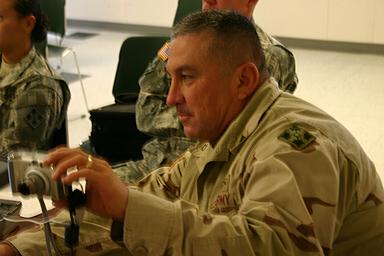![]() 1st Battalion 22nd Infantry
1st Battalion 22nd Infantry ![]()
RAIDER BRIGADE CONDUCTS BATS TRAINING
By Maj. David J. Olson, 1st BCT, 4th ID PAO
December 2005
Spc Troy Wollan,
A medic with |
FORT HOOD, Texas – The 1st Brigade Combat Team, 4th Infantry Division continues to train here prior to departure for Operation Iraqi Freedom even though their equipment is already enroute to the Middle East. One event the Raider Brigade focused on is the Biometric Automated Tool Set training for various unit personnel who are expected to handle the detention of enemy combatants. A Mobile Training Team from Fort Huachuca, Ariz. came here to train the personnel from several units who will be using the BATS equipment in their duties handling detainees. Capt. Clyde Ball, the provost marshall officer for the Raider Brigade, explained that BATS gives Coalition Forces the ability to track people. “We may not know if we found a bad guy, but the BATS will tell us.” |
The
BATS creates a detainee database for detainment operations at
multiple levels: division, corps and U.S. Central Command, said
Ball.
The database is built from digital information collected using
the BATS features: photograph, fingerprint and retinal scan
capabilities.
Additional information is entered into the computer such as the
subject’s hair color, height, weight, age and so on.
The BATS was designed for the FBI and other agencies within the
Department of Homeland Security.
“The basic BATS system is 22-pounds,” said Peggy
Heinrich, a contractor on the MTT. It is portable and easily
carried around the battlefield.
The primary purpose of the BATS system is for the detainee
database, said Ball. He sited an example of using the BATS on the
battlefield
after an Improvised Explosive Device attack. After the attack,
BATS can be used to collect information from a number of
bystanders or witnesses.
“If we capture a guy after an IED attack and enter him in
the computer, we may find that he was involved in other IED
strikes,” said Ball.
“We do a data dump a couple times a day,” said
Heinrich. The information is shared with all levels in the
network.
“Everybody talks,” said Heinrich. “The Army and
the Marine servers talk to each other. It goes all the way up and
all the way down.”
“It [BATS] does an exhaustive search of the left and right
index fingers to get a match,” said Heinrich. “It is as
updated as the last down load.”
When asked about the compatibility of other digital cameras,
Heinrich explained, “anyone can take a picture with a
digital camera,
download it to the [BATS] computer and we can check the database
for a match.”
So when a patrol collects data from a guy in Ball’s example
after an IED attack, the BATS can tell them they are dealing with
a bad guy.
The bad guy can be detained for questioning. “It’s an
easy system to use,” added Heinrich.
There are other uses for the BATS
system such as an access system to the Tactical
Operations Center. Pfc. Ollie Davis, a fueler with Company C, 4th Support Battalion, agreed. “It seems to be easy to use.” Regardless of where the BATS system is used, it will be a valuable tool in 1st BCT’s tool box. BATS is an example of the digitized capability of the 4th Inf. Div. as they are the U.S. Army’s premiere digital formation. Meanwhile, the Raider Brigade is trained and ready to deploy and conduct any mission in Iraq that it is given. |
SGT Sandra
Dockham, a motor |

Staff Sergeant Gilbert Cruz, a
Bradley Section Leader
from Company A 1st Battalion 22nd Infantry Regiment
takes an image of his battle buddy during BATS training.
Story and photos by Maj. David J. Olson, 1st BCT, 4th ID PAO
Home | Photos | Battles & History | Current |
Rosters & Reports | Medal of Honor | Killed
in Action |
Personnel Locator | Commanders | Station
List | Campaigns |
Honors | Insignia & Memorabilia | 4-42
Artillery | Taps |
What's New | Editorial | Links |